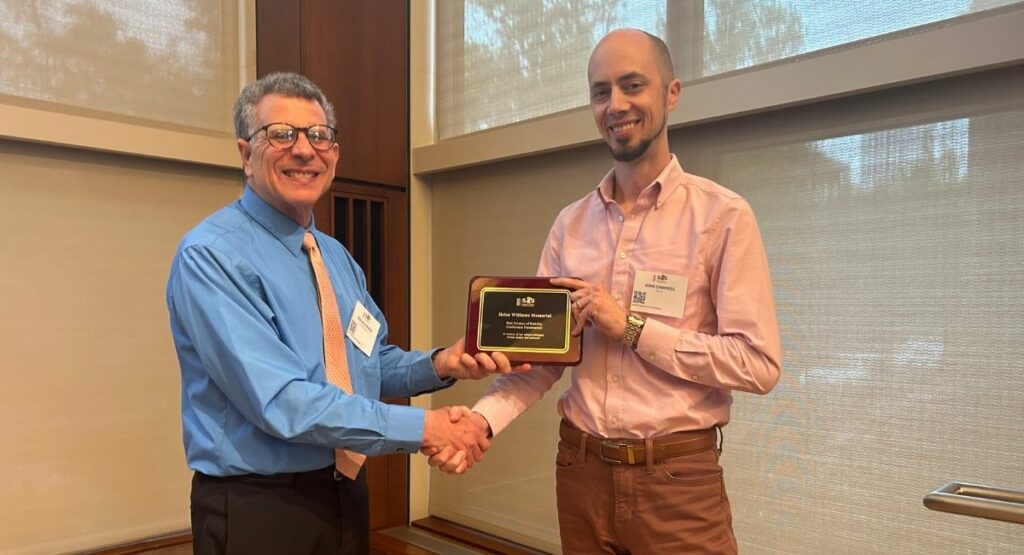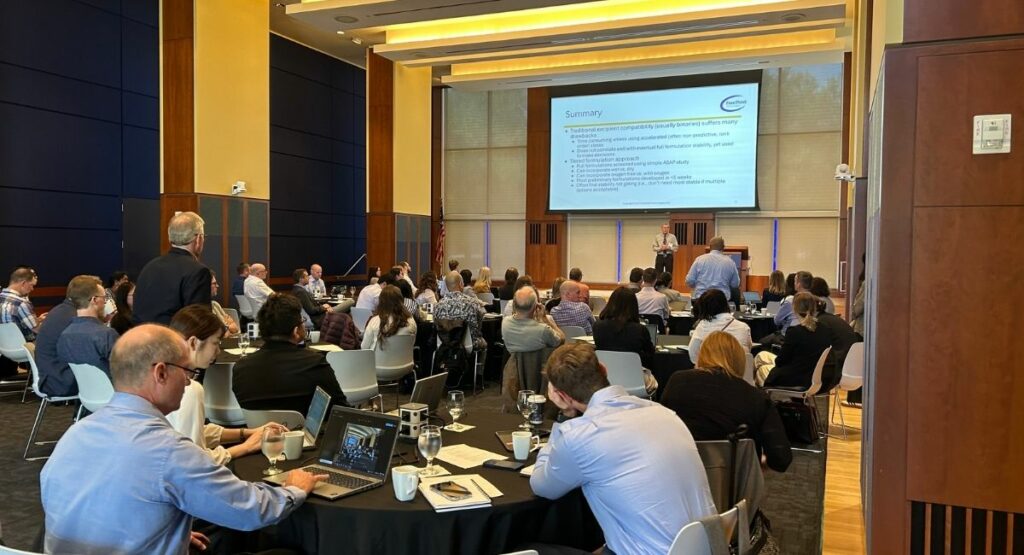The Science of Stability (SoS) 2025 conference, recently held in Philadelphia, brought together leading experts from the pharmaceutical industry and academia. Co-hosted by Lhasa Limited and FreeThink Technologies, this year’s event was a hub for collaboration and discussions. Attendees consistently praised the conference’s thematic structure and unparalleled networking opportunities, with many reporting a significant ‘increase in knowledge surrounding stability and forced degradation’ and a chance to ‘learn about the new in predictive sciences.’ Lhasa Limited was proud to facilitate these vital connections, helping drive forward the future of drug development.
“I loved hearing from so many different speakers with a variety of backgrounds. The receptions were also a great opportunity to meet new people!”
DAY 1: Understanding forced degradation studies
Day one focused on “what happened” in chemical degradation. Eduardo De La Toba (Eli Lilly) highlighted variability in hydrogen peroxide forced degradation studies. Kausik K Nanda (Merck) presented “not so usual” degradation pathways, emphasising that degradation chemistry can deviate significantly from initial expectations. Steve Baertschi (Baertschi Consulting) illustrated this with a Metronidazole case study, where mass balance problems arose from unusual degradation products. These presentations underscored the complexity of forced degradation studies and the critical role of in silico tools.

Day 1: “What has happened?”. Conference attendees watch Rachel and Jonathan’s talk on the first day of the conference in Philadelphia
Rachel Hemingway and Jonathan Lockett (Lhasa Limited) presented on how to solve real-world stability problems using in silico knowledge. They demonstrated how our software for the design and interpretation of forced degradation studies, Zeneth, can:
- Provide chemical degradation predictions with likelihood scores, guiding experimental focus
- Aid in structural elucidation of unknown degradants
- Support nitrosamine risk assessment by identifying potential nitrosamines and providing mechanistic rationale
- Assist in addressing regulatory deficiency letters by helping to explain mechanistic routes for impurities.
These examples clearly illustrate how Zeneth not only streamlines investigations and reduces experimental burden but also provides a robust scientific foundation for critical decisions. Jack Hodgson (Lhasa Limited) further elaborated on how incorporating physicochemical descriptors significantly enhances the accuracy of Zeneth’s predictions.
A highlight of the conference was John Campbell’s (GSK) presentation on “Assessing Mass Balance in Stress Testing (Forced Degradation) Studies.” His insightful talk emphasised that evaluating mass balance (a hot topic at the conference this year) increases confidence in analytical methods and is a regulatory expectation.
John’s practical approach and clear explanations resonated with the audience, earning him the prestigious Helen Williams Memorial Prize for Best Conference Talk. As John explained, factors such as response factor differences, poor recovery, not well-understood chemistry, and chromatographic issues can cause mass imbalance, underscoring the need for robust scientific understanding of the degradation chemistry involved. Zeneth supports this by providing structural information for expected degradants and helping define the endpoint for experimental studies, ensuring all possible degradation chemistry is identified for method development.

John picks up his award for best conference talk for ‘Assessing mass balance in stress testing (forced degradation) studies’
“I liked how the talks were organised based on a theme each day. I also enjoyed the end of day networking and social events that were organised for all attendees.”
Day 2: Accelerated stability prediction: The science of “how fast?”
Day two focused on “how fast did it happen,” exploring the rate of degradation and regulatory updates. Yan Wu (Merck) presented findings from a 2024 industry survey, showcasing the widespread adoption of Risk-Based Predictive Stability (RBPS) approaches, particularly Accelerated Stability Assessment Program (ASAP). Megan McMahon (Pfizer) provided a crucial update on the ICH Q1 Revision, which aims to streamline guidelines, address gaps, and incorporate risk management strategies, notably allowing for flexibility in extrapolation and re-test periods for well-characterised biologicals.

Day 2: “How fast did it happen?” Day two was all about regulatory updates and accelerated stability modelling
Patrick Kelleher (FreeThink Technologies) introduced a novel formalism for accelerated predictive stability for oxygen-sensitive products. Yi Li (Gilead) explored predicting dissolution slowdown using empirical and neural network models. Ken Waterman articulated Quality by Design (QbD) principles for stability, emphasising defining a “Design space.” Ghamdan Beshr (UCB Pharma), Mariah Ultramari and Iris Belitsky (Spektra/Consult Lhasa), followed by Kevin Day (AstraZeneca), highlighted the practical applications of ASAP across drug development, from shelf-life prediction to packaging optimisation, accelerating the time to market for generic drugs and post-approval changes.
Day 3: Tackling nitrosamines: Advancements in nitrosamine control and mitigation
Day three focussed strongly on nitrosamine control, a topic of ongoing importance to the industry.
Rachel Hemingway (Lhasa Limited) presented “The Lhasa Nitrites Database.” This powerful tool enhances understanding and management of N-Nitrosamine formation risk in drug substances and products. With 2,570 total nitrite results across 132 different products, it is the largest and continuously growing compilation of nitrite data in the industry, a testament to its collaborative data-sharing initiative. The database provides crucial supporting data for robust nitrosamine risk assessments, informs formulation strategies, and facilitates engagement with excipient suppliers for low nitrite grade excipients.
Jean Daou discussed “Mitigating Nitrosamine Contamination in Pharmaceutical Packaging Using NSORB Films,” focusing on innovative packaging solutions as part of nitrosamine mitigation. Rowan Meador from GSK gave a notable talk, titled “The chemistry of nitrosamine inhibitors and structure elucidation of inhibitor byproducts formed under forced nitrosation conditions.” This presentation explored nitrosamine inhibitors as potential excipients, offering crucial insights into proactive mitigation strategies.
Zeneth: Your solution for real-world stability challenges in drug development
The Science of Stability 2025 conference demonstrated how experimental studies and in silico tools can be used together for safer, more confident decision-making.
The Science of Stability conference truly showcased how scientific advancements and innovative tools are revolutionising drug development. As a not-for-profit organisation, Lhasa Limited is proud to be at the forefront of this progress, empowering scientists with intuitive decision-support tools like Zeneth.
We would like to extend a big thank you to all our speakers, the SoS 2025 committee, and everyone who attended the event, making it a great success!
We look forward to supporting these vital discussions, updates, and collaborations annually with our co-host FreeThink Technologies, as we work together to advance chemical safety and pharmaceutical development.
Would you like to learn more?
- Visit our dedicated Science of Stability website for conference slides and details
- Join our SOS LinkedIn group to stay updated on next year’s conference
- Ready to see Zeneth in action? Contact our team today to discover how our in silico tools can revolutionise your forced degradation studies
- Don’t miss out on future Lhasa events – sign up for our newsletter!
Last Updated on June 19, 2025 by lhasalimited



